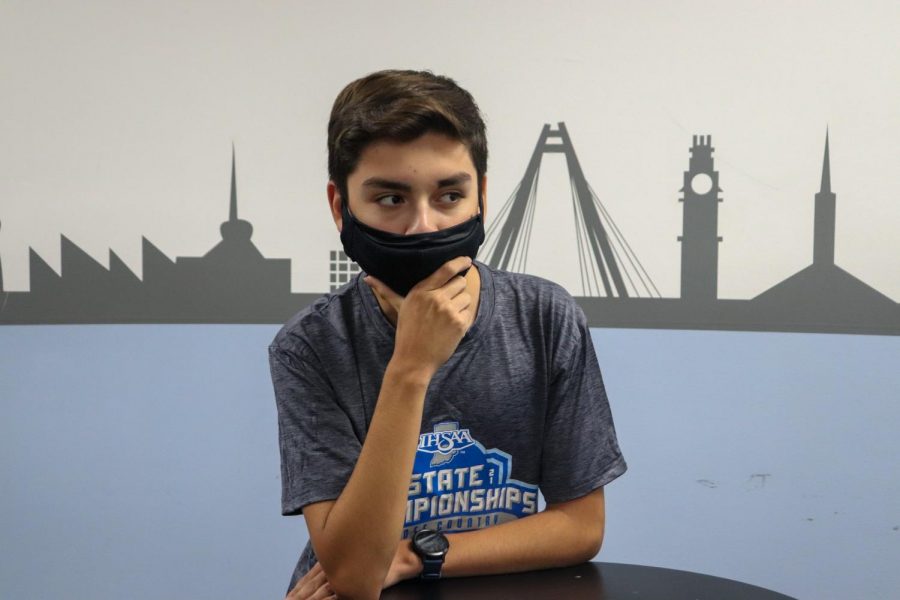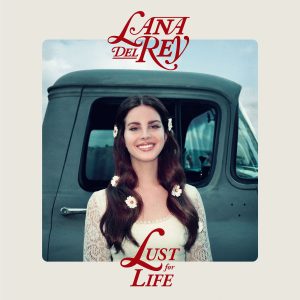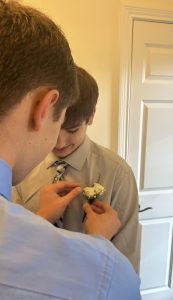Decisions, Decisions
Students tackle challenging moral dilemmas
November 22, 2021
55.4 percent of North students would be willing to commit a crime. Another 83.7 percent would aid a robbery. Welcome to the world of moral dilemmas, where context can force people to think the unthinkable.
Students make thousands of decisions every day, but some carry much more weight than others. However, some decisions are much weightier than others — and making the wrong choice can carry a steep cost. In some situations, there are no right answers. Moral dilemmas are designed to get people to think about why they make the choices they do.
A classic dilemma called the Trolley Problem is an example of this. A runaway trolley is tumbling toward a group of five workers. On another track is a single worker. There’s a lever that can be pulled to change the trolley’s track. Is the best choice to leave the switch, killing five people, or flip it, killing the single worker? Although this is a decision that’s very unlikely to come up in real life, the premise has many parallels to everyday dilemmas.
A Triangle survey given to students in psychology and sociology classes brought up this dilemma, along with several others. Regarding the trolley problem, 80.4 percent of the 92 students said they would pull the lever. One respondent summarized the reasoning of those who chose this.
“Even though both are morally bad decisions, being a bystander who does nothing to prevent a greater wrong is worse than being a guilty hero who did something to save lives,” the student said.
Other students were more conflicted. A separate student argued that it would be best to pull the lever, but it wouldn’t be right to do so.
“It is not up to me to decide who lives or dies,” a second student said. “In my opinion, one death is better than five, but then I would be responsible for the death of that one person. If I did nothing, I wouldn’t be responsible for those deaths.”
When it comes to family, some people will go to great lengths to save one another. The Medicine Dilemma asks about even breaking the law for someone. Suppose your mother is dying from a certain type of cancer. There is only one drug that could save her, but the chemist is charging way more than you can afford. The only way to save your mother is to steal the drug.
Asking students at North what they would do 55 percent said they would steal the drug for their mother.
Junior Angie Villegas believes you should.
“I feel like it really shouldn’t because even if he doesn’t love her, a life is still a life,” Villegas said. “Even if it was someone you hated, I think you should still jump in front of a car for them just to save their lives.”
Sophomore AJ Valencia disagrees and wouldn’t steal the medicine for someone you didn’t know or hated.
“Honestly, I don’t see any point in risking my neck for somebody else that I don’t really know,” Valencia said.
55.4 percent of students would save their mother by stealing the drug, but wouldn’t for people they didn’t know.
When you want something bad enough you’ll do almost anything to get it. Joe’s Dilemma talks about a boy who really wanted to go to a concert, but his dad said he could only go if he got the money himself. Joe worked very hard to raise the money and ended up reaching his goal. However, just before the concert his dad needed money for his own benefit and asked Joe to give him his money. Should Joe give him the money, was his dad even right to ask?
Most students surveyed said Joe should keep the money for himself as he worked hard and deserves the money.
“Joe’s dad told him he could go if he paid for it himself, and Joe worked hard and earned the money,” a third student said. “It is unfair for his dad to ask for the money to go on a special trip.”
Most students surveyed agreed that Joe should be the one to keep the money as he worked hard and earned it himself.
The Money Dilemma is one with mixed responses. Two brothers who must urgently leave town need money. The oldest brother, Karl, broke into a store and stole a thousand dollars. The youngest brother, Bob, lied to an old man and said he was very sick and needed money, and lied about paying him back. Both brothers then had a thousand dollars and skipped town. Who was more wrong?
One out of four students believed Karl was in the wrong, but the majority think what Bob did was the worst.
“Even though Karl stole from a store, he didn’t lie and create a whole situation,” they said. “Bob lied to a caring old man just to steal the money, knowing he will never pay him back.
Some students disagree and think what Karl did was worse
“He broke in and stole it,” they said. “Stealing like that is worse.”
The story of Robin Hood is a well-known fable. Is it right to steal from the wealthy and give the spoils to the poor? A modern adaptation of this dilemma asks whether a person who knows the identity of a bank robber who donated the money to an orphanage should tell the police. One respondent makes a reasoned defense of the robber.
“He was possibly sacrificing himself in order to save more lives than his own,” they said. “He donated the money, so he didn’t steal to make a profit. While he could have found a different way to make money, this was still a selfless act at its heart.”
For 9.8 percent of respondents, the right thing to do would be to turn him in.
“He still stole, which is against the law and not right no matter what it is for,” one said.
This dilemma had a large disparity between what the students would do and what they believed to be right. 83.7 percent wouldn’t turn the robber in, but just 47.8 percent believed he had a good reason for committing the crime. It makes for an interesting contrast between one’s convictions and one’s actions.
The Medicine Dilemma, Joe’s Dilemma and Bob’s Dilemma were all designed by researcher Lawrence Kohlberg. He sought to categorize people as belonging to one of six moral stages, ranging from blind obedience to universal moral principles. Taking a somewhat negative view, he proposed that only 10 or 15% of people ever reached this higher stage. Junior Rafaela Franco applied the stages to students at North.
“I believe that [myself] and most students at North are at stage 3, Social Contract,” Franco said. “Us teenagers are all in a phase in our lives where we identify with rebellion and fight against the rules that are pressed against us.”
The basic idea of categorizing moral stages may seem like a good way to organize the world, but it’s worth noting the criticisms of the model. Morality is deeply personal; an argument can be made, for example, that respecting authority should be the most advanced stage because society requires it to run smoothly.
Interesting though they may be, some dilemmas seem difficult to apply to everyday life. It’s difficult to imagine a scenario where a hapless North student would be put in charge of controlling a runaway trolley. By viewing them more abstractly, it becomes easier to draw real-world connections.
The basic premise of the Trolley Problem comes down to this: is it better to take action and save more people, or do nothing, resulting in more casualties but absolving yourself of guilt? The Medicine Dilemma boils down to prioritizing life or profit. The Robin Hood Dilemma is a sort of variation on this, asking whether the needs of the wealthy or of the poor should come first.
It may be that the best answer to these questions is a simple “I don’t know.” It can be hard for a person to know what course of action to take unless they found themselves in that situation — and some things are much easier said than done.
“I don’t know. I really don’t know if I would kill 5 people or one [unsuspecting] person,” Reyes said.






